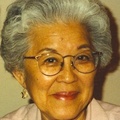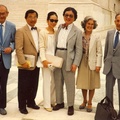Influenced and inspired by others
A powerful statement was submitted to the CWRIC during a public hearing in San Francisco on August 13, 1981, by Raymond Okamura, an historical revisionist and activist. Okamura’s 1981 statement to the CWRIC was a compelling review of euphemisms, such as “relocation,” “evacuation,” and other terms that were identical to those on my growing “Work in Progress” list. A year later, his concerns were shared with a broader audience when his letter to the commission was adapted and published as an article in The Journal of Ethnic Studies (1982) with a provocative title, “The American Concentration Camps: A Cover-Up through Euphemistic Terminology.” Okamura made a direct connection between euphemisms employed by Nazi Germans and those used by Americans:
The government of the Third Reich (Nazi Germany) utilized an elaborate system of euphemisms to cover up what was actually happening to millions of European Jews, Gypsies, and other groups deemed undesirable. ‘Emigration,’ ‘evacuation,’ ‘final solution,’ ‘relocation,’ ‘resettlement,’ and ‘special treatment’ were used as code words for the Nazi program of mass murder.1
Okamura’s reference to Nazi German euphemisms was a political hot potato. While his article probably went unnoticed beyond a small audience of academic readers and was based on undeniable facts, such a connection was far too polemical for most to accept. It would take years before such terms as “concentration camps” would be accepted as accurate descriptions of sites to incarcerate political prisoners–and as recent books by scholars, such as Alice Yang Murray and Greg Robinson reveal–that struggle for a more accurate nomenclature for the World War II Nikkei diaspora and gulag experience is still not completely resolved.2
The Okamura article was not only a list of specific euphemisms, but also a scathing indictment of scholars who contributed to the problem:
Books published during, or shortly after the [war] invariably used the government euphemisms without qualification or explanation. Since most of these early books were written by camp administrators and government employed or affiliated scholars, it is no wonder that the ‘evacuation-relocation’ nomenclature saturates these works.... Beginning with the ethnic awareness movements in the late 1960s, the term concentration camp and internment have frequently appeared in book titles. Although many authors have used titles like America’s Concentration Camps, Concentration Camps USA...none has systematically replaced euphemistic terminology in their text.... An incongruous situation exists wherein authors provocatively use internment or concentration camp in their titles, but revert to the old ‘evacuation-relocation’ nomenclature in their text, tables, and illustrations. The record needs rewriting.3
Okamura’s barely veiled criticism of America’s Concentration Camps and Concentration Camps USA did not go unnoticed by their author, Roger Daniels, who observed later in his keynote address to a large audience at a 1983 conference on “Relocation, Redress, and the Report: A Historical Appraisal,” that “Raymond Okamura has recently charged me and other scholars with being part of a cover-up.”4 But Daniels, whose pioneering scholarship and publications had launched revisionist scholarship on the Nikkei, was already aware of the need to confront the euphemism problem, and in that same keynote speech said:
...it is important that we call things by their proper names. George Orwell has taught us that twentieth-century political speech is largely ‘the defense of the indefensible’ and that political language consists ‘largely of euphemism’. This certainly has been true of language used to describe the relocation. From Karl R. Bendetsen’s5 memos, which habitually describe Japanese Americans as non aliens,’ to the congressional statute that created the Commission and beyond, euphemisms have prevailed. Rather than the ‘Commission on Wartime Relocation and Internment of Civilians,’ it should have been ‘incarceration of civilians.’6
The CWRIC’s final report to the Congress, published in 1982 as Personal Justice Denied, exacerbated rather than resolved the euphemism controversy. For example, this statement from the report admitted on the one hand, that terms like “concentration camps” had indeed been widely used by U.S. officials, but then concluded by supporting the use of wartime euphemisms:
There is a continuing controversy over the contention that the camps were ‘concentration camps’ and that any other term is a euphemism. The government documents of the time frequently use the term ‘concentration camps,’ but after World War II, with full realization of the atrocities committed by the Nazis in the death camps of Europe, that phrase came to have a very different meaning. The American relocation centers were bleak and bare, and life in them had many hardships, but they were not extermination camps, nor did the American government embrace a policy of torture or liquidation of the ethnic Japanese. To use the phrase ‘concentration camps’ summons up images and ideas which are inaccurate and unfair. The Commission has used ‘relocation centers’ and ‘relocation camps,’ the usual term used during the war, not to gloss over the hardships of the camps, but in an effort to find an historically fair and accurate phrase.7
To his credit, Professor Daniels pursued his argument against euphemisms with renewed vigor. Regarding the oft-used (and insidiously misleading) term “internment,” he pointed out its historical origins in the Boer War, its longstanding definition in international law, how “internment” is grossly misused and poses a clear and present danger to a true understanding of what happened to U.S. citizens in World War II–and how, if not corrected, it can happen again to some other group:
‘Internment’ is a well-defined legal process by which enemy nationals [i.e., Issei,8] who were not allowed to become U.S. citizens] are placed in confinement in time of war.... What happened to the…West Coast Japanese was lawless. Citizen and alien, male and female, old and young, all were simply swept up, placed in the holding pens from Santa Anita to Puyallup, and then shipped out to ten desolate camps.
Daniels continued to research and refine his thoughts about euphemisms over the years, sharing with other researchers drafts of an evolving interpretive essay on the subject. In 2005 it was published as “Words Do Matter: A Note on Inappropriate Terminology and the Incarceration of the Japanese Americans” as a chapter in a history of Nikkei in the Pacific Northwest.9 It is a sweeping overview of how euphemisms have been used by U.S. officials to obscure and conceal what really happened, from the War of 1812 to the recent era of official duplicity and obfuscation in the wake of the events on “9-11.” His concluding statement is a powerful clarion call to reject euphemistic deceptions, and worth repeating:
As I have tried to show, there has been a long history of euphemistic language about the wartime atrocity that was wreaked upon the Japanese Americans of the West Coast during and after World War II. Begun with malice aforethought by government officials, politicians, and journalists, it has been continued, largely in thoughtless innocence, by scholars. As we are in the seventh decade after the promulgation of Executive Order 9066, it is high time that scholars begin to call things by their right names. Let us hear no more about the ‘internment of the Japanese Americans’.10
Notes:
1. Raymond Okamura. “The American Concentration Camps: A Cover-Up through Euphemistic Terminology,” The Journal of Ethnic Studies (Vol.10, No.3, 1982) 95-109.
2. Some scholars are still ambivalent, as reflected by historian Alice Yang Murray:
...scholars and activists declared that Japanese Americans were confined in ‘concentration camps’ and cited evidence that wartime officials, Supreme Court justices, and members of the press had used that phrase. They noted that using the term internment to describe the ten camps was technically incorrect ... they argued that the [WRA] camps fulfilled the dictionary definition of a concentration camp…. Yet although I agree that places like Manzanar and Tule Lake in California fulfilled the dictionary definition of a concentration camp, I personally can’t accept this designation [emphasis mine].... I considered using the term ‘concentration camp’ in the title...but then decided it might prevent me from reaching many potential readers. I want this book to be read by the very people who are alienated by the term ‘concentration camp’....
Alice Yang Murray. Historical Memories of the Japanese American Internment and the Struggle for Redress (Stanford, California: Stanford University Press, 2008); quoted by Roger Daniels at the end of his essay on “Words Do Matter: A Note on Inappropriate Terminology and the Incarceration of Japanese Americans,” in Louis Fiset and Gail Nomura, eds. Nikkei in the Pacific Northwest: Japanese Americans and Japanese Canadians in the Twentieth Century (Seattle, Washington: University of Washington Press, 2005), p. 214. Also see: Greg Robinson. “A Note on Terminology” in Tragedy of Democracy, Japanese Confinement in North America (Columbia University Press, 2009), pp. vii-viii.
3. Raymond Okamura. p. 99.
4. Roger Daniels, et al (eds.). Japanese Americans: From Relocation to Redress, Rev. p. 6.
5. Karl R. Bendetsen, Col., Assistant Chief of Staff for Civil Affairs Division, Western Defense Command, and director of WDC’s Wartime Civil Control Administration.
6. Roger Daniels, et al (eds.). Japanese Americans, From Relocation to Redress, Rev. p. 6. Also see: Eric L. Muller. American Inquisition: The Hunt for Japanese American Disloyalty in World War I. (Chapel Hill: University of North Carolina Press, 2007).
7. Commission on Wartime Relocation and Internment of Civilians. Personal Justice Denied: Report of the Commission on Wartime Relocation and Internment of Civilians (Washington, D.C.: Government Printing Office, 1982), p. 27. Reprinted by the University of Washington Press, with a “Foreword” by Tetsuden Kashima, 1997.
8. See Eiichiro Azuma. Between Two Empires: Race, History, and Transnationalism in Japanese America (New York: Oxford University Press, 2005); Roger Daniels. Asian America: Chinese and Japanese in the United States Since 1850 (Seattle: University of Washington Press, 1988); and Yuji Ichioka. The Issei: The World of the First Generation Japanese Immigrants, 1885-1924 (New York: Macmillan, 1988).
9. Roger Daniels. “Words Do Matter.” pp. 183-207.
10. Ibid.
*Note: This essay has circulated over the past decade among friends and research associates with the working title “Work in Progress: Terminology – WW II exclusion/incarceration of West Coast Japanese-Americans.” Copyright © 2009. Rev. 2010.
© 2009 Aiko Herzig-Yoshinaga




